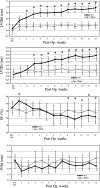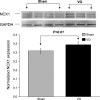Mechanical work and energetic analysis of eccentric cardiac remodeling in a volume overload heart failure in rats
- PMID: 19201995
- PMCID: PMC2670699
- DOI: 10.1152/ajpheart.01120.2008
Mechanical work and energetic analysis of eccentric cardiac remodeling in a volume overload heart failure in rats
Abstract
Eccentric cardiac remodeling seen in dilated cardiomyopathy or regurgitant valvular disease is a well-known process of heart failure progression, but its mechanoenergetic profile has not been yet established. We made a volume overload (VO) heart failure model in rats and for the first time investigated left ventricular (LV) mechanical work and energetics in cross-circulated whole heart preparations. Laparotomy was performed in 14 Wistar male rats, and abdominal aortic-inferior vena caval shunt was created in seven rats (VO group). Another seven rats underwent a sham operation without functional shunt (Sham group). LV dimensions changes were followed with weekly transthoracic echocardiography. Three months after surgery, we measured LV pressure and volume and myocardial O(2) consumption in isolated heart cross circulation. LV internal dimensions in both systolic and diastolic phases were significantly increased in the VO group versus the Sham group (P < 0.05). LV pressure was markedly decreased in the VO group versus in the Sham group (P < 0.05). LV end-systolic pressure-volume relation shifted downward, and myocardial O(2) consumption related to Ca(2+) handling significantly decreased. The contractile response to Ca(2+) infusion was attenuated. Nevertheless, the increase in Ca(2+) handling-related O(2) consumption per unit change in LV contractility in the VO group was significantly higher than that in the Sham group (P < 0.05). The levels of sarco(endo)plasmic reticulum Ca(2+)-ATPase 2a protein were reduced in the VO group (P < 0.01). In conclusion, VO failing rat hearts had a character of marked contractile dysfunction accompanied with less efficient energy utilization in the Ca(2+) handling processes. These results suggest that restoring Ca(2+) handling in excitation-contraction coupling would improve the contractility of the myocardium after eccentric cardiac remodeling.
Figures









References
-
- Abe T, Ohga Y, Tabayashi N, Kobayashi S, Sakata S, Misawa H, Tsuji T, Kohzuki H, Suga H, Taniguchi S, Takaki M. Left ventricular diastolic dysfunction in type 2 diabetes mellitus model rats. Am J Physiol Heart Circ Physiol 282: H138–H148, 2002. - PubMed
-
- Arai M, Matsui H, Periasamy M. Sarcoplasmic reticulum gene expression in cardiac hypertrophy and heart failure. Circ Res 74: 555–564, 1994. - PubMed
-
- Bers DM Calcium fluxes involved in control of cardiac myocyte contraction. Circ Res 87: 275–281, 2000. - PubMed
-
- Cantor EJ, Babick AP, Vasanji Z, Dhalla NS, Netticadan T. A comparative serial echocardiographic analysis of cardiac structure and function in rats subjected to pressure or volume overload. J Mol Cell Cardiol 38: 777–786, 2005. - PubMed
-
- Garcia R, Diebold S. Simple, rapid, and effective method of producing aortocaval shunts in the rat. Cardiovasc Res 24: 430–432, 1990. - PubMed
Publication types
MeSH terms
Substances
Grants and funding
LinkOut - more resources
Full Text Sources
Medical
Miscellaneous

